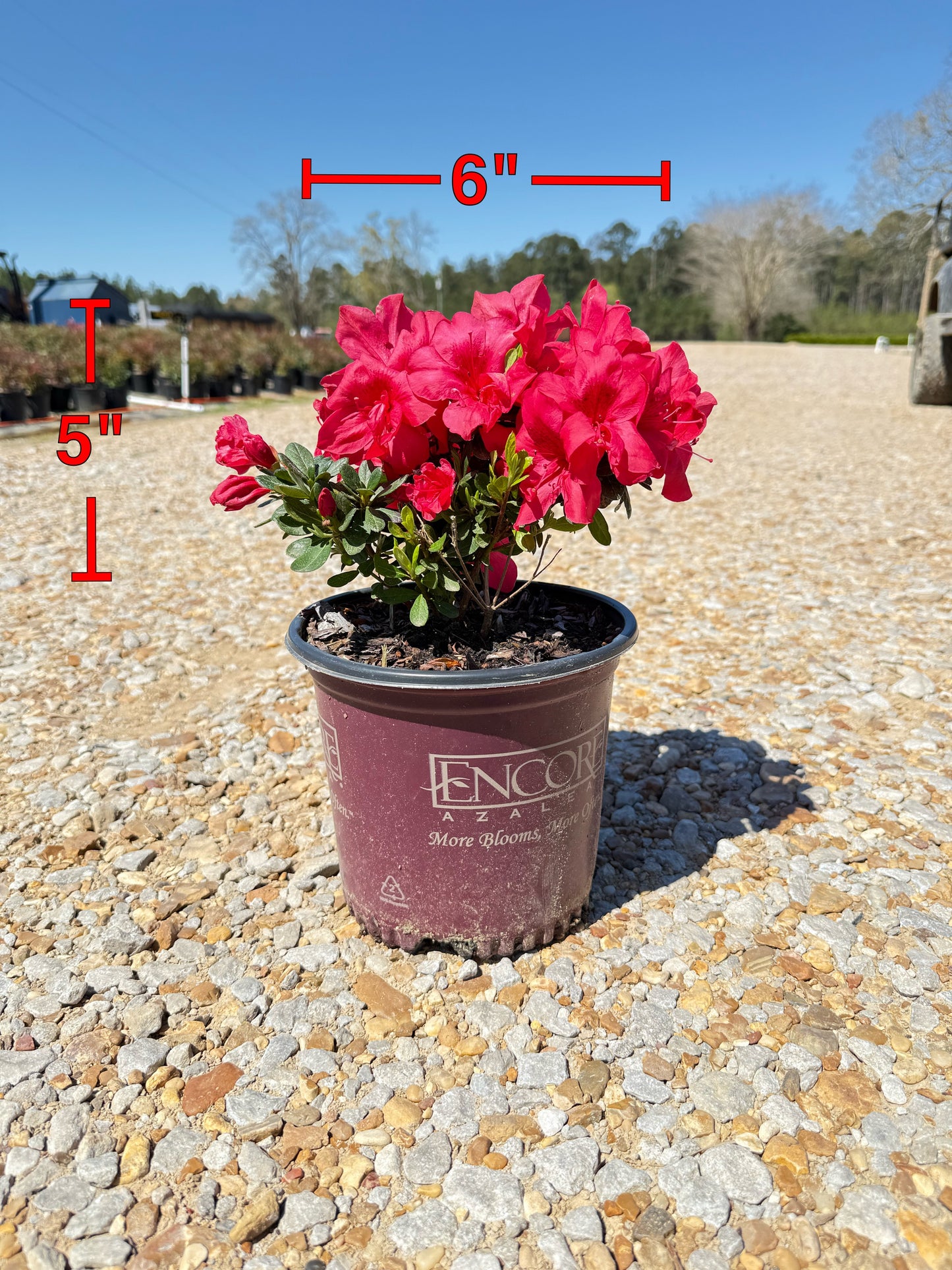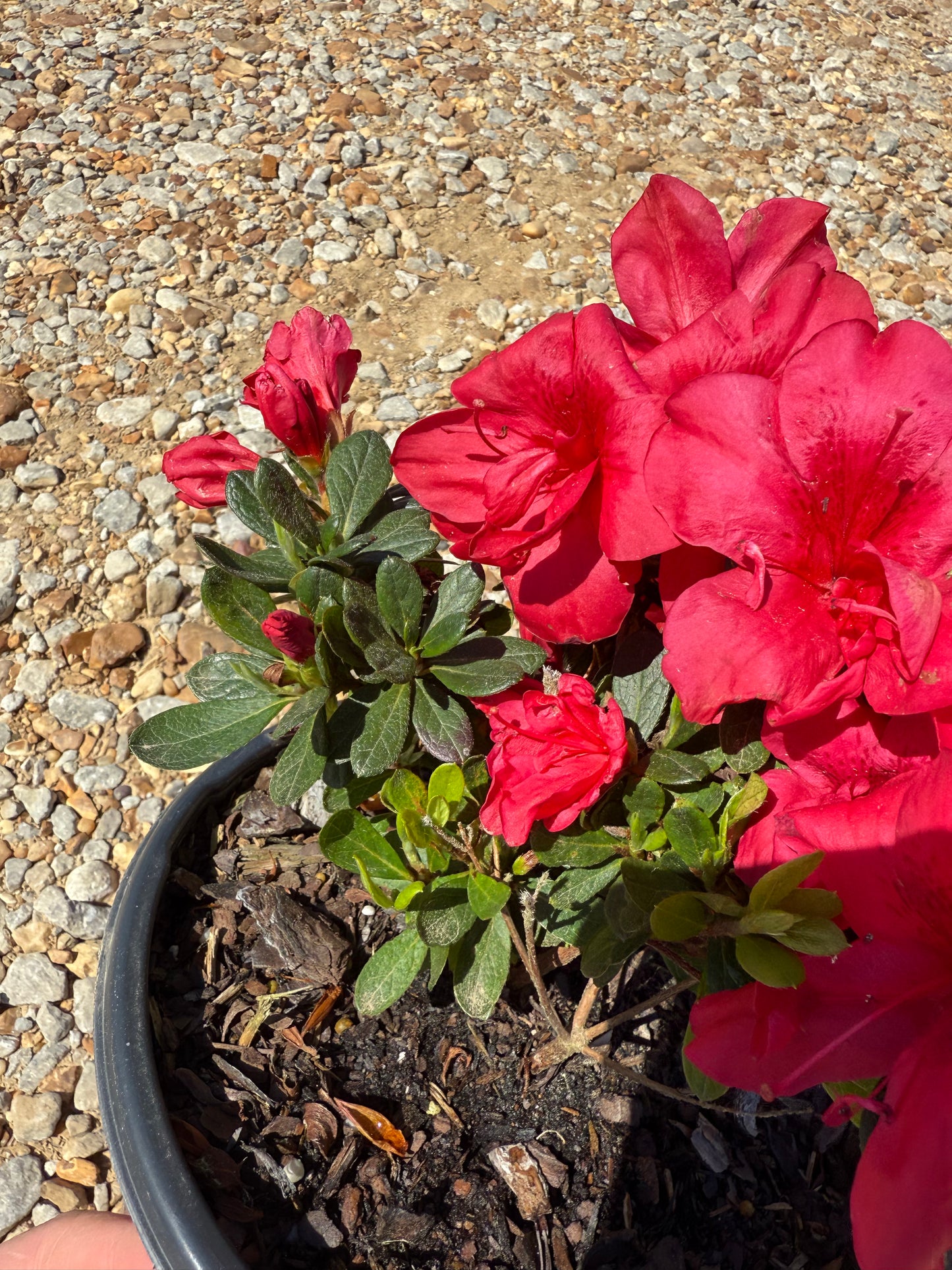Autumn Bonfire Azalea™
Autumn Bonfire Azalea™
Couldn't load pickup availability
![]() Get it between Friday April 4th - Monday April 7th
Get it between Friday April 4th - Monday April 7th
zone-5, zone-6, zone-7, zone-8, and zone-9
Description
Description
Fast growing in an upright position, the applications of the Autumn Bonfire Azalea are numerous. Anyone looking for something that glows need look no further, the fire of the Bonfire Azalea is a great value add to all gardens.
- FAST GROWING: Holding it’s green color all throughout the year, the new Autumn Bonfire Azalea is a great grower with blooms coming to fruition in the summer and fall.
- DARK FIREY COLORS: With reds that could be stolen from a campfire at night, the semi-double and single blooms are an appealing addition to any garden needing a flare of something spark-like.
- UPRIGHT AND DENSE: With it’s ability to grow well and do so upright, the fiery reds of its flowers stand out wonderfully against the darker green backdrop of the plant’a foliage. With dense growth, this is a striking plant to behold at its full growth.
Shipping & Returns
Shipping & Returns
Shipping:
Shipping live plants sometimes has its challenges when dealing with inclement weather but we strive to have every single order shipped out on their scheduled shipping date. Most orders will be scheduled to ship within 1-2 weeks of ordering. Because a plant needs TLC we only ship out on Mondays-Wednesdays to ensure the plants aren’t stationed somewhere over the weekend with no water or sunlight.
When to Ship:
We can ship out plants at anytime of the year pruned or not pruned, cold or not cold. Each plant’s durabilty is different so we recommend having them shipped in their designated season but we will still ship your plant to you earlier if you choose so.
Returns:
Because plants are perishable they cannot be returned without prior permission. We work hard to ensure all plants arrive healthy, but on rare occasions issues with the plant health upon delivery do arise.
Every single shipped plant is healthy upon departing our facility but if a plant is received in poor health contact us immediately so that we can assess the problem and work on saving the plant. We will first need a photo of the plant to start a claim. If we determine your plant cannot be recovered we will send you a replacement immediately. If notified of the plants health within 4 days we will send a replacement 100% free of charge.
If you determine the plant not to be healthy 4 days after delivery you can contact us and we will issue a 50% store credit.
30 days after delivery we cannot be held responsible for the current health of the plant.
Wholesale & Bulk Orders
Wholesale & Bulk Orders
To get started or learn more about our wholesale program and pricing please complete this form.
Questions & Answers
Have a Question?
-
Should I plant my red blooming Azalea in the ground
Yes, you can plant your Bonfire Azalea in the ground. It thrives in well-draining, slightly acidic soil with partial to full sun. Ensure the planting site has good drainage, as azaleas do not tolerate standing water.
-
what zones should this be planted? Will it work for New Jersey 7b zone?
Grows best in USDA zones 6–10. Yes, it will thrive in zone 7b with proper care.
-
How does it do in direct sunlight? We live in zip code 28469.
Thrives in full sun but benefits from afternoon shade in hot climates.
-
I live in SC zone 8A, my bed gets one hour of morning sun and 2 hours of early afternoon sun. Would the autumn bonfire flourish in this situation?
Autumn Bonfire Azalea prefers 4–6 hours of sun for best blooms. With only 3 hours, flowering may be reduced, but it can still survive. More sun improves performance.
-
do you have any other varieties of encore azaleas
Yes! We have 12 different varieties of the autumn encore azaleas. You can use the search bar at the top right-hand corner and type in autumn azaleas and they will pop up.
-
How tall ànd wide Do it get
The Autumn Bonfire Azalea is a compact, reblooming variety from the Encore Azalea series. It typically reaches a mature height of 3 feet (0.9 meters) and a mature width of 3 to 3.5 feet (0.9 to 1.1 meters).
Growth Characteristics:
- Height: 3 feet
- Width: 3 to 3.5 feet
- Growth Rate: Moderate
This azalea is known for its vibrant, deep red blooms that appear in spring, summer, and fall, making it a popular choice for adding consistent color to the garden throughout the growing season. Its compact size makes it suitable for borders, containers, or small garden spaces.
-
My azalea is very healthy but doesn't blossom!
If your azalea is healthy but not blooming, several factors could be affecting its ability to produce flowers. Here are some common reasons and tips to encourage blooming:
1. Insufficient Sunlight:
- Light Requirements: While azaleas generally prefer partial shade, they still need some sunlight to bloom. Ideally, they should get morning sun with some afternoon shade. If your azalea is in deep shade, it may not receive enough light to stimulate flower production. Consider relocating it to a spot with more sunlight, or trimming nearby trees or shrubs that might be blocking light.
2. Improper Pruning:
- Pruning Timing: Azaleas bloom on old wood, which means they form their flower buds in the summer for the following spring. If you prune too late in the season (after midsummer), you might be cutting off next year's flower buds. The best time to prune is right after the blooms fade in the spring.
3. Over-Fertilization:
- Too Much Nitrogen: Excessive nitrogen can promote lush foliage growth at the expense of flowers. Use a fertilizer specifically formulated for acid-loving plants, and be careful not to over-fertilize. Fertilize in early spring and possibly again after flowering, but avoid high-nitrogen fertilizers.
4. Soil pH:
- Soil Acidity: Azaleas prefer acidic soil with a pH between 4.5 and 6.0. If the soil is too alkaline, it can hinder blooming. You can test your soil's pH and amend it with sulfur or an acidifying fertilizer if necessary.
5. Watering Issues:
- Consistent Moisture: Azaleas need consistent moisture, especially during the bud-forming period in late summer and fall. However, overwatering or poor drainage can lead to root problems, which might affect blooming. Make sure the soil is well-drained and water deeply but infrequently.
6. Age and Maturity:
- Plant Age: If your azalea is young, it might not yet be mature enough to produce flowers. Some azaleas take a few years to establish themselves before they start blooming consistently.
7. Pests or Diseases:
- Hidden Stress: While your azalea may appear healthy, underlying pest issues or diseases could be causing stress that inhibits blooming. Check for signs of pests like lace bugs or diseases like root rot.
8. Cold Damage:
- Late Frost: If there was a late frost after the buds had formed, it could have damaged them, preventing blooming. Protecting the plant from unexpected cold snaps can help preserve the buds.
Encouraging Blooming:
- Ensure your azalea gets the right balance of sunlight and shade.
- Prune immediately after flowering to avoid cutting off next year's buds.
- Use an acid-loving plant fertilizer in moderation.
- Keep the soil acidic and well-drained.
- Water consistently, especially during dry spells and the bud-forming period.
Summary:
To encourage your azalea to bloom, ensure it's getting enough light, prune at the right time, avoid over-fertilization, and maintain proper soil conditions. With the right care, your azalea should start producing beautiful blooms.
Excellent packaging, plant in very good conditions.
Thank you . My plant is nice and healthy and exactly what I needed to match the one that was giving to me .






